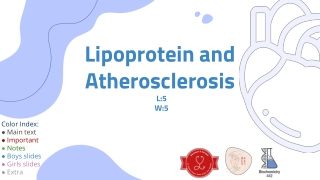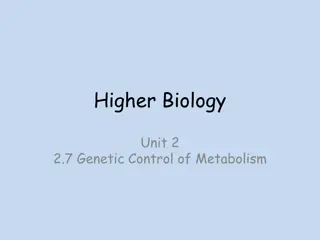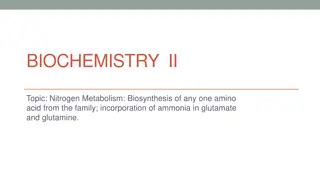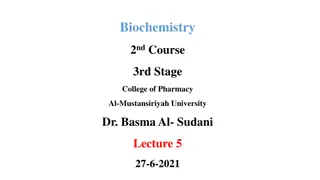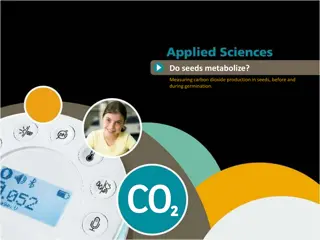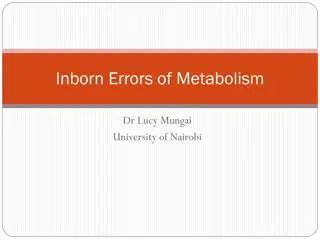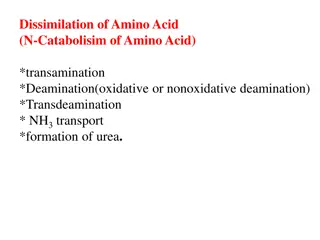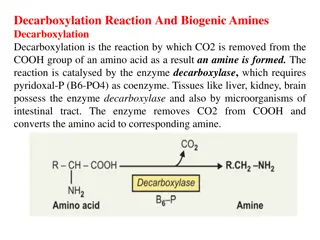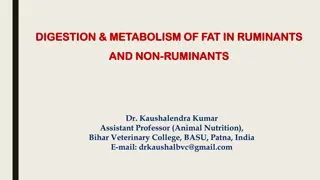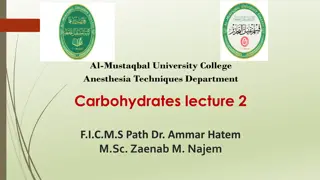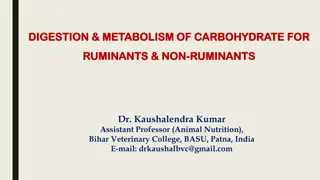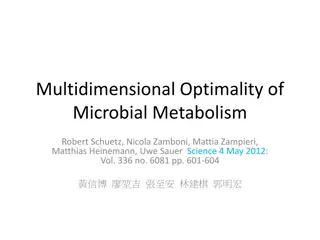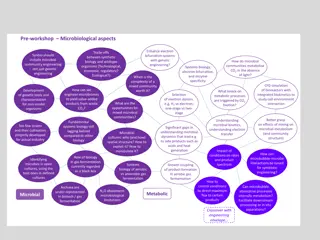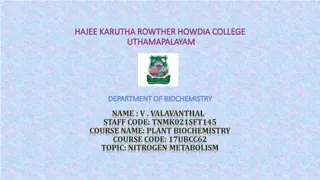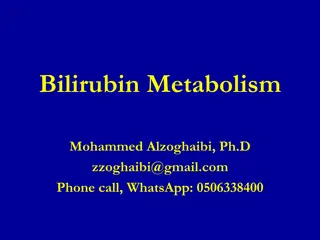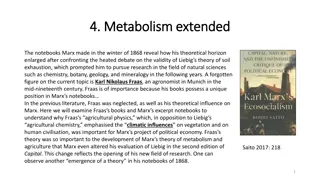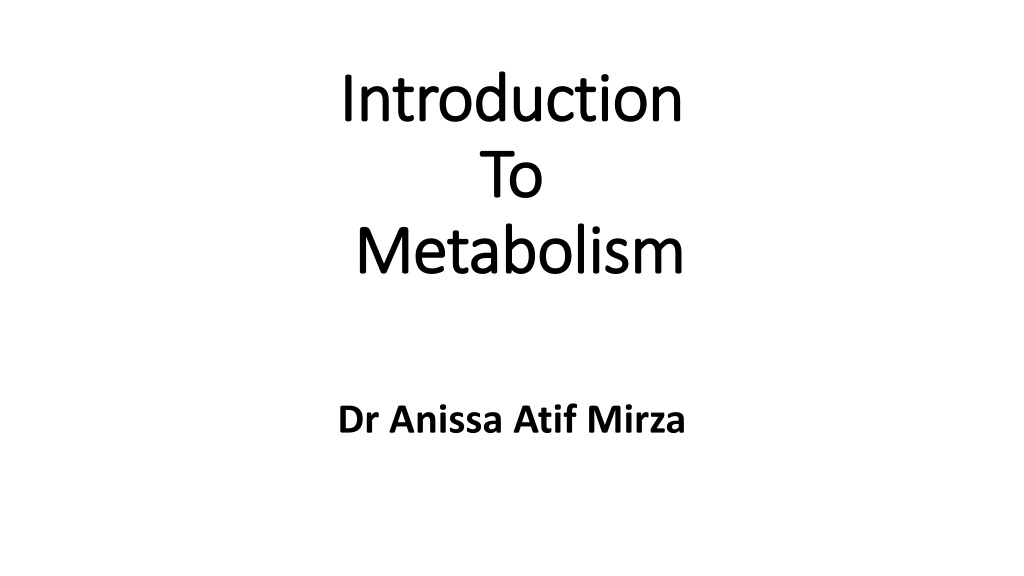
Understanding Metabolism: A Comprehensive Overview
Explore the intricate world of metabolism with Dr. Anissa Atif Mirza as she delves into the network of biochemical reactions that occur in living cells. Learn how metabolism converts nutrients into energy, simplifies complex substances, and plays a vital role in health, growth, and reproduction. Discover the importance of enzymes and hormones in regulating metabolic processes.
Download Presentation

Please find below an Image/Link to download the presentation.
The content on the website is provided AS IS for your information and personal use only. It may not be sold, licensed, or shared on other websites without obtaining consent from the author. If you encounter any issues during the download, it is possible that the publisher has removed the file from their server.
You are allowed to download the files provided on this website for personal or commercial use, subject to the condition that they are used lawfully. All files are the property of their respective owners.
The content on the website is provided AS IS for your information and personal use only. It may not be sold, licensed, or shared on other websites without obtaining consent from the author.
E N D
Presentation Transcript
Introduction Introduction To To Metabolism Metabolism Dr Anissa Atif Mirza
What is Metabolism? What is Metabolism?
Metabolism is a network of metabolic /biochemical reactions. Carried out in living cells. In a well organized, integrated and regulated manner. Related to various biomolecules viz Carbohydrates Lipids Proteins Nucleoproteins
Metabolism involves interconversions of chemical compounds in the body. Metabolite precursors are transformed to end products via many specific intermediates.
Metabolism is the sum of the chemical changes that convert: Nutrients into energy. Chemically complex substances of cells into simpler forms. Chemically simple substances into functional complex biomolecules.
The Sun is Energy for Life Phototrophs (Plants) use light to drive synthesis of organic molecules. Heterotrophs (Animals) use these as building blocks. CO2,O2 and H2O are recycled.
Importance Of Metabolism Importance Of Metabolism Normal Metabolism is vital for health, growth, reproduction and good survival of human beings.
Role of Enzymes and Hormones Role of Enzymes and Hormones in Metabolism in Metabolism
Enzymes along with Coenzymes biocatalyzespecific metabolic reactions. Thus Enzymes are Functional units of Metabolism
Hormones are chemical messengers of human body. They are regulators of Enzyme activity. (Hormones Stimulate/Inhibit Enzyme activity)
Enzyme reactions are organized into discrete pathways.
Metabolite Metabolite Metabolite is a substrate or a reactant undergoing a biochemical/metabolic reaction.
Metabolic Reaction Metabolic Reaction Metabolic reaction is a biochemical reaction where a metabolite is specifically reacted by an Enzyme and Coenzyme to give a product. A E-Co B
Types Of Metabolic Reactions Types Of Metabolic Reactions Reversible Reactions Same Enzyme is required. Not regulatory steps. E1 A E1 B
Irreversible Reactions- Different set of Enzyme required. Non equilibrium Reactions. Regulatory steps. E2 CE3D
Types Of Types Of Biochemical Reactions Biochemical Reactions
Oxidation/Dehydrogenation/Hyd roxylation Reduction Hydrolytic Carboxylation Decarboxylation
Phosphorylation Dephosphorylation Amination Deamination Isomerization Hydration Dehydration
Metabolic Pathway Metabolic Pathway Metabolic pathway is a series of well defined and significant biochemical reactions followed one after another giving intermediate products and finally end product of the pathway.
A Precursor of the pathway (A) E1 B E2 C E3 Intermediates of the pathway (B,C,D) D E4 E End Product of the pathway (E)
Organization of Pathways Organization of Pathways Pathways consist of sequential steps. The enzymes may be separate. May form a multienzyme complex. May be a membrane-bound system. New research indicates that multienzyme complexes are more common than once thought.
Mutienzyme complex Separate enzymes Membrane Bound System
Organization of Pathways Closed Loop (intermediates recycled) Linear Spiral (product of rxns are substrates for subsequent rxns) (same set of enzymes used repeatedly)
Compartmentalization Of Metabolic Pathways
Compartmentalization of pathways permits integration and regulation of metabolism.
Types Of Metabolic Pathway Types Of Metabolic Pathway Catabolic/Degradative /Energy Generating/ATP producing Pathways/Exothermic. Anabolic/Synthetic/Energy Utilizing/ ATP Using Pathways/Endothermic.
Catabolic pathways involve oxidative reactions producing reducing equivalents- NADH+H+ and FADH2. Catabolic pathways converge to few end products.
Anabolic pathways diverge to synthesize many biomolecules.
Some pathways serve both in catabolism and anabolism ,those are Amphibolic pathways.
Amphibolic Pathways occur at the crossroads of metabolism. Amphibolic pathways links between Anabolic and Catabolic pathways.
Regulation of Metabolic Regulation of Metabolic Pathways Pathways
Regulation means stimulation and inhibition of pathways as per cellular need. Hormones regulate the metabolic pathways. Metabolic pathways are regulated to allow the organism to respond to changing conditions.
Every metabolic pathway has its specific regulatory enzymes/key enzymes. Hormones regulate by either stimulating /inhibiting the regulatory/key enzymes of the pathway.
Modes Of Metabolic Regulation Allosteric regulation Covalent modification Control of enzyme levels Compartmentalization Metabolic specialization of organs
Feedback inhibition product of pathway down regulates activity of early step in pathway
Feedforward activation metabolite produced early in pathway activates down stream enzyme
Regulating Related Catabolic and Regulating Related Catabolic and Anabolic Pathways Anabolic Pathways Anabolic & catabolic pathways involving the same compounds are not the same. Some steps may be common to both Others must be different - to ensure that each pathway is spontaneous. This also allows regulation mechanisms to turn one pathway onn and the other off.
Modes Of Enzymes Regulation Modes Of Enzymes Regulation Alteration in membrane permeability. Conversion of Inactive to Active form. Stimulation of mRNA translation. Induction of new mRNA formation. Repression of mRNA formation.
Knowledge of normal metabolism is essential for : Understanding adaptations of Starvation Exercise Pregnancy and lactation. Understanding of metabolic disorders.
Abnormal Metabolism Is Due To Abnormal Metabolism Is Due To Nutritional Deficiencies Enzyme Defects Hormonal Defects Drug and Toxin Interactions
Normal Enzyme and Hormonal activities gives normal metabolism and health to human body. Defect in Enzymes and Hormonesderange the normal metabolism.
Derangement in Metabolism Derangement in Metabolism Any defect or derangement in normal pattern of metabolism leads to metabolic disorders. Mutation in Genes of Enzymes, forms defective Enzymes. Congenital defect of Enzyme leads to Inborn Error Of Metabolism.
Inborn Error Of Metabolism Inborn Error Of Metabolism Congenital deficiency of any single Enzyme of a metabolic pathway leads to Inborn Errors of Metabolism.
Enzyme Deficiency of a Enzyme Deficiency of a Metabolic Pathway Metabolic Pathway Blocks the metabolic reaction. Blocks the metabolic pathway. Accumulates and excreteintermediate product of the pathway. No formation of end product of the pathway. Affects other interrelated metabolic pathways.
Methods Used to Study Metabolism Methods Used to Study Metabolism Metabolic Reactions/Metabolic Pathways were studied : Using whole organism/Cellular fractions Using Metabolic Probes. Using Radioisotopes.

